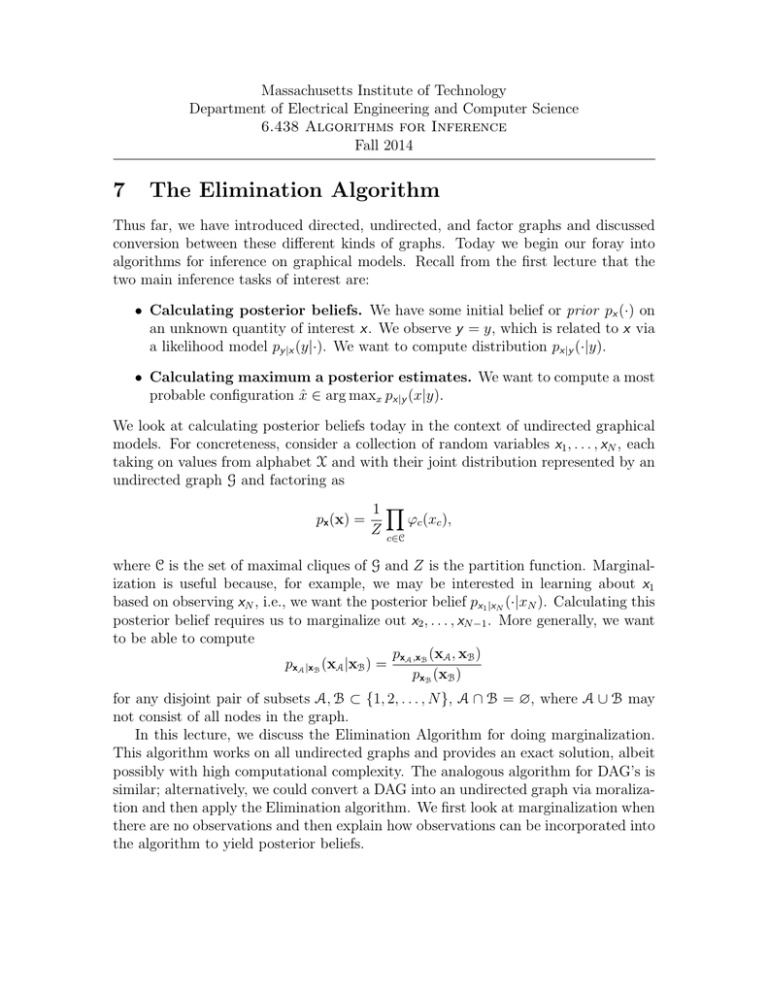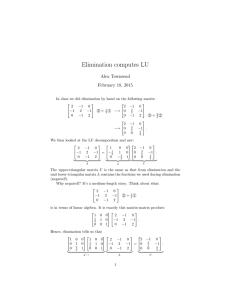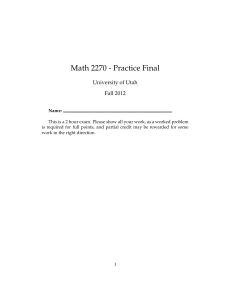Document 13512681
advertisement

Massachusetts Institute of Technology
Department of Electrical Engineering and Computer Science
6.438 Algorithms for Inference
Fall 2014
7
The Elimination Algorithm
Thus far, we have introduced directed, undirected, and factor graphs and discussed
conversion between these different kinds of graphs. Today we begin our foray into
algorithms for inference on graphical models. Recall from the first lecture that the
two main inference tasks of interest are:
• Calculating posterior beliefs. We have some initial belief or prior px (·) on
an unknown quantity of interest x. We observe y = y, which is related to x via
a likelihood model py |x (y|·). We want to compute distribution px|y (·|y).
• Calculating maximum a posterior estimates. We want to compute a most
probable configuration x̂ ∈ arg maxx px|y (x|y).
We look at calculating posterior beliefs today in the context of undirected graphical
models. For concreteness, consider a collection of random variables x1 , . . . , xN , each
taking on values from alphabet X and with their joint distribution represented by an
undirected graph G and factoring as
px (x) =
1�
ϕc (xc ),
Z c∈C
where C is the set of maximal cliques of G and Z is the partition function. Marginal­
ization is useful because, for example, we may be interested in learning about x1
based on observing xN , i.e., we want the posterior belief px1 |xN (·|xN ). Calculating this
posterior belief requires us to marginalize out x2 , . . . , xN −1 . More generally, we want
to be able to compute
px ,x (xA , xB )
pxA |xB (xA |xB ) = A B
pxB (xB )
for any disjoint pair of subsets A, B ⊂ {1, 2, . . . , N }, A ∩ B = ∅, where A ∪ B may
not consist of all nodes in the graph.
In this lecture, we discuss the Elimination Algorithm for doing marginalization.
This algorithm works on all undirected graphs and provides an exact solution, albeit
possibly with high computational complexity. The analogous algorithm for DAG’s is
similar; alternatively, we could convert a DAG into an undirected graph via moraliza­
tion and then apply the Elimination algorithm. We first look at marginalization when
there are no observations and then explain how observations can be incorporated into
the algorithm to yield posterior beliefs.
7.1
Intuition for the Elimination Algorithm
We first develop some intuition for what the Elimination Algorithm does via the
following example graph on random variables x1 , x2 , . . . , x5 ∈ X:
x3
x4
x2
x5
x1
Figure 1: Our running example for today’s lecture.
The corresponding probability distribution factors as:
px (x) ∝ ϕ12 (x1 , x2 )ϕ13 (x1 , x3 )ϕ25 (x2 , x5 )ϕ345 (x3 , x4 , x5 ),
(1)
where the ϕ’s are the potential functions for the maximal cliques in the graph.
Suppose we want marginal px1 (·). The naive brute-force approach is to first com­
pute the joint probability table over all the random variables and then sum out
x2 , . . . , x5 :
px (x),
(2)
px1 (x1 ) =
x2 ,x3 ,x4 ,x5 ∈X
which requires O(|X|5 ) operations.
Can we do better? Observe that by plugging in factorization (1) into equation (2),
we obtain
px1 (x1 ) =
px (x)
x2 ,x3 ,x4 ,x5 ∈X
∝
ϕ12 (x1 , x2 )ϕ13 (x1 , x3 )ϕ25 (x2 , x5 )ϕ345 (x3 , x4 , x5 ).
x2 ,x3 ,x4 ,x5 ∈X
Notice that choosing which order we sum out variables could make a difference in
computational complexity!
For example, consider an “elimination ordering” (5, 4, 3, 2, 1) where we sum out
x5 first, x4 second, and so forth until we get to x1 , which we do not sum out. Then,
2
we can push around some sums:
X
ϕ12 (x1 , x2 )ϕ13 (x1 , x3 )ϕ25 (x2 , x5 )ϕ345 (x3 , x4 , x5 )
px1 (x1 ) ∝
x2 ,x3 ,x4 ,x5 ∈X
=
X
ϕ12 (x1 , x2 )ϕ13 (x1 , x3 )
x2 ,x3 ,x4 ∈X
X
ϕ25 (x2 , x5 )ϕ345 (x3 , x4 , x5 )
x5 ∈X
�
=
X
im5 (x2 ,x3 ,x4 )
'
ϕ12 (x1 , x2 )ϕ13 (x1 , x3 )m5 (x2 , x3 , x4 )
x2 ,x3 ,x4 ∈X
=
X
ϕ12 (x1 , x2 )ϕ13 (x1 , x3 )
x2 ,x3 ∈X
X
�
=
X
m5 (x2 , x3 , x4 )
x4 ∈X
im4 (x2 ,x3 )
'
ϕ12 (x1 , x2 )ϕ13 (x1 , x3 )m4 (x2 , x3 )
x2 ,x3 ∈X
=
X
ϕ12 (x1 , x2 )
x2 ∈X
X
ϕ13 (x1 , x3 )m4 (x2 , x3 )
x3 ∈X
�
=
X
im3 (x2 )
'
ϕ12 (x1 , x2 )m3 (x2 )
x2 ∈X
i m2 (x1 ).
What happened here is that we computed intermediate tables m5 , m4 , m3 , and m2 .
At the very end, to compute the marginal on x1 , we just normalize m2 to get px1 (x1 ):
px1 (x1 ) =
m2 (x1 )
.
'
x/ ∈X m2 (x )
The above procedure is the Elimination Algorithm for our specific example graph
using elimination ordering (5, 4, 3, 2, 1). Note that the intermediate tables are given
the letter m to suggest that these can be interpreted as messages. For example,
m5 (x2 , x3 , x4 ) can be thought of as all the information x5 has to give to its neigh­
bors x2 , x3 , and x4 . Later on, we will see more of these so-called “message-passing”
algorithms.
What is the computational complexity? Intuitively, this depends on the elimina­
tion ordering. For the elimination ordering (5, 4, 3, 2, 1), note that the most expensive
summation carried out was in computing m5 , which required forming a table over
four variables and summing out x5 . This incurs a cost of O(|X|4 ). Each of the other
summations was cheaper, so the overall computational complexity is O(|X|4 ), an im­
provement over the naive brute-force approach’s complexity of O(|X|5 ). But can we
do better? In fact, we can! Think about what happens if we use elimination ordering
(4, 5, 3, 2, 1).
3
What about if we have some observations? For example, let’s say that we observed
x3 = a. Then the above procedure still works, provided that we force the value of x3
to be a and not sum over x3 . The normalization step at the end ensures that we have
a valid conditional probability distribution, corresponding to the posterior belief for
x1 given x3 = a. Another way to see this is to note that observing x3 = a is equivalent
to placing a delta-function singleton potential on x3 : ϕ3 (x3 ) = 1 if x3 = a and 0
otherwise–then running the Elimination Algorithm as usual gives us the posterior of
x1 given x3 .
7.2
The Elimination Algorithm
As we saw in our example, the Elimination Algorithm is just about marginalizing out
variables in a particular order, at each step summing only over the relevant potentials
and messages.
In general, the key idea is to maintain a list of “active potentials.” This list
starts off as the collection of all potential functions for our graph, including possibly
the delta-function singleton potentials on observed nodes. Each time we eliminate
a variable by summing it out, at least one potential function gets removed from the
list of active potentials and a new message (which acts as a potential) gets added to
the list. In the earlier example, upon eliminating x5 , potentials ϕ25 and ϕ345 were
removed from the list of active potentials whereas m5 was added to the list. With
this bookkeeping in mind, we present the Elimination Algorithm:
4
Input: Potentials ϕc for c ∈ C, subset A to compute marginal pxA (·) over, and
an elimination ordering I
Output: Marginal pxA (·)
Initialize active potentials Ψ to be the set of input potentials.
for node i in I that is not in A do
Let Si be the set of all nodes (not including i) that share a potential with
node i.
Let Ψi be the set of potentials in Ψ involving xi .
Compute
X Y
�
mi (xSi ) =
ϕ(xi ∪ xSi ).
xi ϕ∈Ψi
Remove elements of Ψi from Ψ.
Add mi to Ψ.
end
Normalize
Y
�
pxA (xA ) ∝
ϕ(xA ).
ϕ∈Ψ
Algorithm 1: The Elimination Algorithm
Let’s analyze the algorithm’s complexity. At each step i, we have a table of size
|X|Si . To fill in each element, we sum |X| terms and multiply |Ψi | terms. This means
that step i, which results in computing message mi requires O(|X|Si · |X||Ψi |) =
O(|Ψi | · |X||Si |+1 ) operations. Thus, the total complexity is
X
O(|Ψi | · |X||Si |+1 ).
i
We can upper-bound |Ψi | with |C| and |Si | with maxi |Si | to obtain
X
X
O(|Ψi | · |X||Si |+1 ) =
O(|C| · |X|maxi |Si |+1 ) = O(N · |C| · |X|maxi |Si |+1 ),
i
i
recalling that big-O is an upper bound. Note that the quantity maxi |Si | dictates how
efficient the Elimination Algorithm will be. We next look a way to compute maxi |Si |.
7.3
Reconstituted Graph
To compute maxi |Si |, we will look at what new edges we introduced during marginal­
ization. Returning to our running example graph from Figure 1 and using elim­
ination ordering (5, 4, 3, 2, 1), upon summing out x5 , we are left with potentials
ϕ12 , ϕ13 , m5 (x2 , x3 , x4 ), which can be viewed as a new graph where the m5 term cou­
ples x2 , x3 , and x4 , i.e., effectively we have added edges (x2 , x3 ) and (x2 , x4 ).
5
In general, when eliminating a node, the node “sends” a message that couples all
its neighbors into a clique. With this analysis, in our running example:
• After eliminating x5 : make {x2 , x3 , x4 } into a clique (add edges (x2 , x3 ) and
(x2 , x4 ))
• After eliminating x4 : make {x2 , x3 } into a clique (already done, so no edge
added)
• After eliminating x3 : make {x1 , x2 } into a clique (already done, so no edge
added)
• After eliminating x2 : nothing left to do
By introducing the added edges into our original graph from Figure 1, we arrive
at what is called the reconstituted graph:
x3
x4
x2
x5
x1
Here, we denote the added edges via dotted lines.
The reconstituted graph has two key properties. First, the largest clique size in
the reconstituted graph is maxi |Si |+1 (note that Si does not include node i) from our
complexity analysis earlier. Second, the reconstituted graph is always chordal, which
means that if we want to make a graph chordal, we could just run the Elimination
Algorithm and then construct the reconstituted graph. Note that the reconstituted
graph depends on the elimination ordering. To see this, try the elimination ordering
(4, 5, 3, 2, 1). The minimum time complexity achieveable using the Elimination Algo­
rithm for a graph is thus given by minI maxi |Si |, referred to as the treewidth of the
graph.
7.4
Grid graph
We end with a neat result, which will be stated without proof. Consider the grid
graph over N = n2 nodes as shown below:
6
...
...
...
...
Brute-force marginalization requires O(|X|N ) operations.
However, it is possible to
√
achieve an elimination ordering where maxi |Si | = N , using the zig-zag pattern
denoted by the arrow
√ above. In fact, any planar graph has an elimination order such
that maxi |Si | = O( N ).
7
MIT OpenCourseWare
http://ocw.mit.edu
6.438 Algorithms for Inference
Fall 2014
For information about citing these materials or our Terms of Use, visit: http://ocw.mit.edu/terms.



